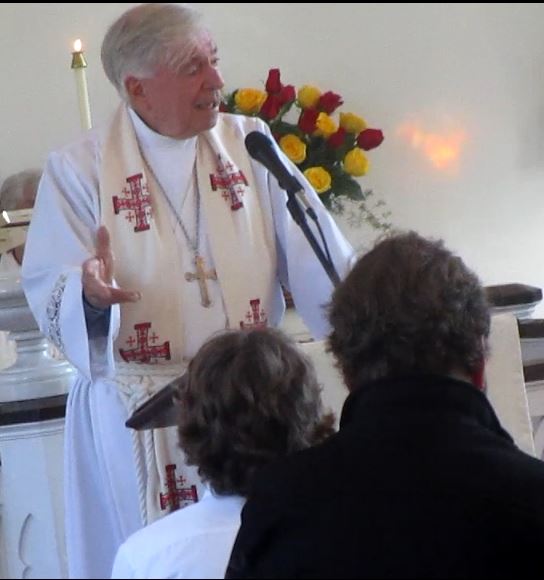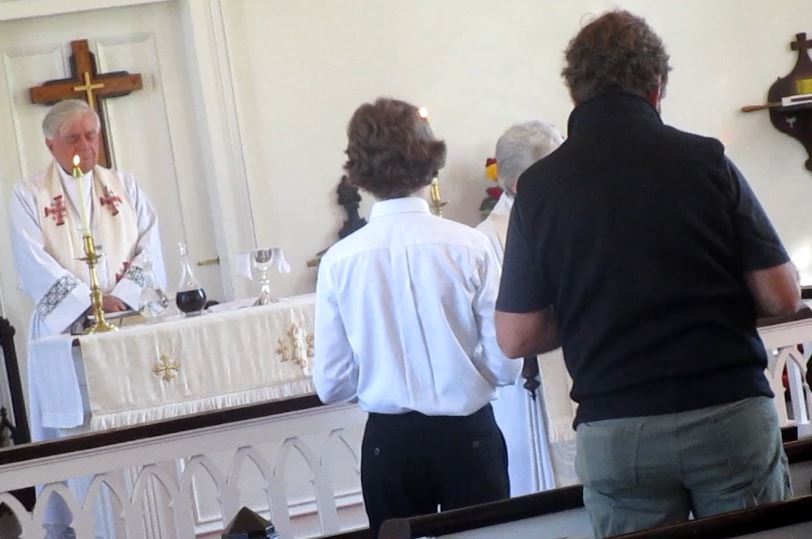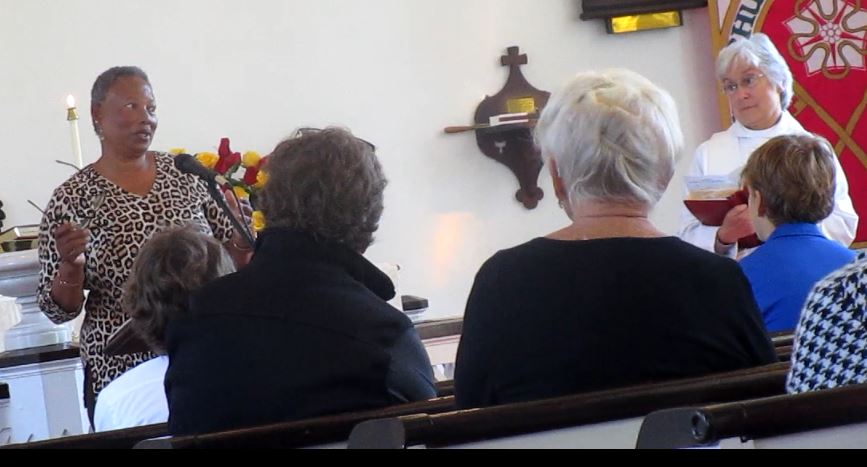2023 Sun Nov 5
Autumnal Tints

Shortly before his death, Henry David Thoreau finished an extraordinary ode to autumn in his essay, “Autumnal Tints.” Enjoy the entire essay here – and read on for a few of its highlights, with Thoreau’s lovely prose laid out as poems for your reading pleasure.
+++++
October is the month of painted leaves.
Their rich glow now flashes round the world.
As fruits and leaves and the day itself
acquire a bright tint just before they fall,
so the year near its setting.
October is its sunset sky;
November the later twilight.
+++++
It is pleasant to walk over the beds
of these fresh, crisp, and rustling leaves.
How beautifully they go to their graves!
How gently lay themselves down
and turn to mould!
Painted of a thousand hues, and fit
to make the beds of us living.
So they troop to their last resting place,
light and frisky. They put on no weeds,
but merrily they go scampering over the earth,
selecting the spot,
choosing a lot,
ordering no iron fence…
How many flutterings
before they rest quietly in their graves!
They that soared so loftily, how contentedly
they return to dust again, and are laid low,
resigned to lie and decay at the foot of the tree,
and afford nourishment to new generations of their kind,
as well as to flutter on high!
They teach us how to die.
+++++
Let your walks now be a little more adventurous;
ascend the hills. If, about the last of October,
you ascend any hill in the outskirts of our town,
and probably of yours, and look over the forest,
you may see well, what I have endeavored to describe.
All this you surely will see, and much more,
if you are prepared to see it,—if you look for it…
Objects are concealed from our view,
not so much because they are out of the course
of our visual ray as because we do not bring
our minds and eyes to bear on them;
for there is no power to see in the eye itself,
any more than in any other jelly.
We do not realize how far and widely,
or how near and narrowly, we are to look.
The greater part of the phenomena of Nature
are for this reason concealed from us all our lives.
The gardener sees only the gardener’s garden…
There is just as much beauty
visible to us in the landscape
as we are prepared to appreciate,
—not a grain more.
+ Henry David Thoreau
All Souls Day (Nov. 2)

As the Western Church spread into northern Europe, it encountered pagan festivals held in late autumn to appease the evil spirits associated with the first killing frosts and the coming of winter, darkness and death.
The Catholic Church had a long-standing policy of incorporating non-Christian traditions into its holidays in order to bring people into the Catholic faith.
In any case, when All Saints’ Day moved to November 1, the church did begin to incorporate supernatural traditions into the holy day’s activities, ideas that don’t have much of a place in Christianity.
Many supernatural ideas persisted in All Saints’ Day Eve celebrations, making the occasion a remarkable combination of Christian and pagan beliefs. At the end of the 10th century, the church tried to give these traditions a little more direction by establishing All Souls’ Day, an occasion to recognize all Christian dead.
Thus, All Souls began with the emphasis on remembering those who had died, broader than just the martyrs. In addition it was cast wide into Catholic theology. In that tradition , the church commemorated all of those who have died and now are in Purgatory, being cleansed of their venial (forgiven) sins and the temporal punishments for the mortal sins that they had confessed and atoning before entering fully into Heaven.
The importance of All Souls Day was made clear by Pope Benedict XV (1914-22), when he granted all priests the privilege of celebrating three Masses on All Souls Day: one, for the faithful departed; one for the priest’s intentions; and one for the intentions of the Holy Father. Only on a handful of other very important feast days are priests allowed to celebrate more than two Masses.
All Souls originally was celebrated in the Easter season, around Pentecost Sunday (and still is in the Eastern Catholic Churches). By the tenth century, the celebration had been moved to October; and sometime between 998 and 1030, St. Odilo of Cluny decreed that it should be celebrated on November 2 in all of the monasteries of his Benedictine congregation. Over the next two centuries, other Benedictines and the Carthusians began to celebrate it in their monasteries as well, and soon it spread to the entire Church.
All Souls is celebrated with Masses and festivities in honor of the dead. The living pray on behalf of Christians who are in purgatory, the state in the afterlife where souls are purified before proceeding to heaven. Souls in purgatory, who are members of the church just like living Christians, must suffer so that they can be purged of their sins. Through prayer and good works, living members of the church may help their departed friends and family. There are two plenary indulgences ( full remission of the punishment due to sin ) attached to All Souls Day, one for visiting a church and another for visiting a cemetery.
Soul Cake!
In medieval times, one popular All Souls’ Day practice was to make "soul cakes," simple bread desserts with a currant topping. In a custom called "souling," children would go door-to-door begging for the cakes, much like modern trick-or- treaters. After its introduction, this holiday did sate many Catholics’ interest in death and the supernatural.
Here is a recipe for Soul Cake
There is a traditional song that accompanies soul cakes:
1. In 2009, Sting put out an album "If On a Winter’s Night". It had a rendition of "Soul Cake". This is a live version in England’s Durham Cathedral.
Here are the lyrics
2. Earlier in 1965 Peter Paul and Mary did "A Soalin"
But the unchristian idea of wandering spirits persisted in some areas, Conceding that they could not completely get rid of the supernatural elements of the celebrations, the Catholic Church began characterizing the spirits as evil forces associated with the devil. This is where we get a lot of the more disturbing Halloween imagery, such as evil witches and demons.
All Saints Day

In our Baptismal Covenant we, along with traditional Christians around the globe, profess in the ancient Baptismal Creed the words: “I believe in… the communion of saints, … the resurrection of the body, and life everlasting.” (Book of Common Prayer, page 304)
From its very beginning, the Church understood the Body of Christ to encompass all baptized persons, both the living and the dead. Christ’s kingdom transcends time and space; and not even death can sever the relationship that the faithful have in Christ.
All are united in a mystical communion with Christ by virtue of baptism (1 Corinthians 6:11). The term saint was used by Paul to designate all baptized Christians (Romans 1:7; 2 Corinthians 1:1; Ephesians 1:1), even the unruly ones (1 Corinthians 1:2)!
In the New Testament, all those who believe and were baptized were referred to as saints. The word saint originally meant "holy".
On All Saints Day, we make celebrate this idea in the here and now by recognizing and celebrating our relationship, not only with those around us today, but also with all those who have gone before us in all times and place. They are connected in one communion.
All Saints is also a time for welcoming new members. Traditionally baptisms are held in the Episcopal Church at the Feast of the Baptism of our Lord, Easter, Pentecost, and All Saints.
It wasn’t until round about the third century that the church began using the word saint to refer to those who had been martyred for the faith
The early Church especially honored martyrs, those who had died for their faith. Praying for the dead is actually borrowed from Judaism, as recorded in 2 Maccabees 12:41-45 of the Apocrypha.
Local churches kept a record of their own martyrs and each year celebrated their “birthdays,” the dates of death when they were “born” into eternal life.
By the fourth century many parts of the Church had set a day of observance for their martyrs, their confessors (those who had been punished for their faith but did not die), and their virgins, all of those known by name and unknown.
The celebration of All Saints’ Day on November 1 began as a feast day commemorating all martyrs, confessors and virgin, including those whose names were not known. In the seventh century, Pope Boniface IV officially established All Saints’ Day in order to honor all the saints at one time.
It was originally celebrated on the first Sunday after Pentecost, and the Eastern Church still observes this date. In the eighth century, Pope Gregory III moved it to November 1.
The confusing aspect of saints is that we have many saints that we honor on specific days. However, there are many unknown or unsung Saints, who may have been forgotten. On All Saints’ Day, we celebrate these Holy Ones of the Lord, and ask for their prayers for us.
Since they are endowed with holiness, saints are close to God, and may perform miracles on earth. Roman Catholics, and some other Christians, honor saints and ask them for guidance in daily life.
Not only is All Saints an occasion on which we might celebrate this communion of saints with prayer, it is also a reminder of God’s desire to sanctify the lives of all God’s people. Too often Christians have used the term saint to describe only those of extraordinary sanctity who have been officially recognized (canonized) by the Church.
But the life of each Christian is to radiate the love of God given to us in Christ so that all the world might know that this love transforms lives.
How do we get Halloween (Oct. 31) from All Saints (Nov. 1) and All Souls(Nov.2)?

What is the Halloween connection ?
Halloween originated in Celtic cultures and spread to Christian.
The word Halloween is a contracted form for All Hallows’ (holy persons or saints) Evening- the day before All Saints.
Halloween has been on Oct 31 because of the Celtic traditions. Halloween also focused not only on death but on the concept of death blending in the supernatural. The Church scheduled All Saints and All Souls after Halloween. The emphasis on All Soul’s focused on those who had died only and did not dwell on stories surrounding death.
All Soul’s did satisfy many Catholics’ interest in death and the supernatural. But the unchristian idea of wandering spirits persisted in some areas. Conceding that they could not completely get rid of the supernatural elements of the celebrations, the Catholic Church began characterizing the spirits as evil forces associated with the devil.
Celtic Tradition
Nov. 1 marked Samhain, the beginning of the Celtic winter. (The Celts lived as early as 2,000 years ago in England, Scotland, Wales, Ireland and northern France.) Samhain, for whom the feast was named, was the Celtic lord of death, and his name literally meant “summer’s end.” Since winter is the season of cold, darkness and death, the Celts soon made the connection with human death.
The eve of Samhain, Oct. 31, was a time of Celtic pagan sacrifice, and Samhain allowed the souls of the dead to return to their earthly homes that evening. Ghosts, witches, goblins and elves came to harm the people, particularly those who had inflicted harm on them in this life. Cats, too, were considered sacred because they had once been human beings who had been changed as a punishment for their evil deeds on this earth
The Roman conquest of England brought two other festivals commemorating the dead.
Photos, Patawomeck Village tour, Nov. 8, 2023, Sacred Ground
Tour notes are here
St. Peter’s Sacred Ground group had a wonderful fall tour of the Patawomeck Indian settlement just east of Fredericksburg on Route 17 on Nov. 8, 2023. The goal of the visit was to understand their history and culture as well as our role as well. They are one of 11 tribes recognized by Virginia.
There is the 1915 home originally owned by Duff Green that has two rooms of history plus an outside village that opened just this year in July. It is a “work in progress”. The tribe did most of the work to repair the house and create the village.
The tribe originally settled in North Stafford but moved south when Quantico took some of the land. The Indians played a major role in helping the Jamestown colony survive during the winter of 1609-1610 (“the starving time”). Unfortunately, the English did not return the favor but pushed them out. A group settled near us in Port Royal from 1750 to 1820 when they then moved to the Little Falls area of Stafford County and coalesced. There are 2,500 in the tribe today. Thanks to Brad Hatch, a member of tribe and Tribal Council for his tour. An excellent tour and definitely a site worth visiting!
Donate to Giving Tuesday, 2023 for the Village Harvest

How we are meeting the challenge?
1. Donating online. Click the “Donate button” to donate to Giving Tuesday in honor of the Village Harvest on Giving Tuesday, Nov. 28, 2023.
2. You can also send a check by mail or donate on Sunday in the plate:
St. Peter’s Church P. O. Box 399 Port Royal, Virginia 22535
We thank you for your donation to support our Village Harvest Food Ministry, now beginning its 10th year in November, 2023.!
Rev. Tom Hughes Sermon Summary, All Saints, Nov. 5, 2023

We are not yet what we shall be. That’s one of Tom’s favorite Bible phrase
“Beloved, we are God’s children now; what we will be has not yet been revealed.”
1 John 3:2
What happens along the way when you are transformed and you become saintly? You are set apart by God. To be transformed in God, you are beyond the law and beyond history. You are unique from any other creature from anyone who has ever been.
That’s what we want to be though we can be side-tracked. We don’t live by the standards of other people but live by what we learn from God.
To be this complete person we have to be honest with ourselves and God, open and without self-deception and that’s why we confess our sins. We need to be free of those things.
We are not controlled by things of this earth. To have our direction of how we live in this world come from God. That’s what sets us apart. What we want to be is genuine, not fake open with ourselves and God.
You are blessed if you adhere to the Beatitudes
We need to open ourselves to God in our lives and let God take the wheel The extent in which we do that is how real or genuine we are. The light of God is shining through them.
Who are these people robed in white? They are robed in the Holy Spirit. We know that is what we should be
The vision is that we are in that parade right now. We know what we shall be, the very creature God meant for us to be. This is the best outcome on the time on this earth and for eternity.
Videos, All Saints Sunday, Nov. 5, 2023
1. Prelude – “For All the Saints”
2. Opening Hymn – “I sing a song of the saints of God”
3. Hymn of praise – “Ye watchers and holy one”
Prayers of the People, All Saints, 2023

The Prayers of the People
We give you thanks for those we have known and loved in this lifetime who rejoice with us, but upon another shore and in a greater light, that multitude which no one can number, and with whom, in your son Jesus Christ, we are one.
James Abourezk, (friend of Linda Kramer), John Anderson (brother of Jim Anderson), Susan Allen (friend of Linda Kramer), Bethune Andrews (sister of Linneth Feliciano), Ruby Barnes (sister of Laura Carey), Mattie Beale (friend of Mary Peterman and Denise Gregory), Easton Buchanan (cousin of Andrea Pogue), John Thomas Carter (Barbara Wisdom’s stepfather), Roger Chartters (friend of the Segars), Pansy Cohen (relative of Andrea Pogue) , Herb Collins (friend of Cookie Davis and Port Royal), David Fannon, David Fitzgerald (son of Lydia O’Neil), Lynn Garrett, Edward Geraci, (brother of Marion Mahoney), Louise Gossett (friend of Catherine Hicks) , Taylor Hayden (member of Scout Troop 304), Joan Johnson (Andrea Pogue’s family) , Billy Long (Larry Saylor’s brother-in- law) Bill McKnight (Chris Fisher’s uncle) , Nancy Newton Nolen (friend of Barabara Segar), Beverly Pauken (Mary Peterman’s sister), Sandra Smith, John Stoddard (friend of the Upshaws), Paris Swisher ( friend of Tom and Alice Hughes), Edith Taylor (friend of Cookie Davis), John Vartonklan, MD., Robert Walker, Jane Harrington Webber (Linda Kramer’s aunt), Jeremiah Williams
Tolling of the Bell
“We Remember Them”- Sylvan Kamens & Rabbi Jack Riemer
At the rising of the sun and at its going down; We remember them.
At the blowing of the wind and in the chill of winter; We remember them.
At the opening of the buds and in the rebirth of spring; We remember them.
At the blueness of the skies and in the warmth of summer; We remember them.
At the rustling of the leaves and in the beauty of the autumn; We remember them.
At the beginning of the year and when it ends; We remember them.
When we are weary and in need of strength; We remember them.
When we are lost and sick at heart; We remember them.
When we have decisions that are difficult to make; We remember them.
When we have joy we long to share; We remember them.
When we have achievements that are based on theirs; We remember them.
For as long as we live, they too will live, for they are now a part of us as, we remember them.
Loving God, you have bound us together in one communion and fellowship. Grant to us, your whole Church in heaven and on earth, your light and your peace as we continue on in our pilgrimage in faith with one another and with Jesus, our companion and friend. Amen.
And now, let us pray for an end to all violence and for the desire to walk the way of Jesus, for if only we follow that path, we will find God’s reign of love here, on this earth.
Lord, make us instruments of your peace. Where there is hatred, let us sow love; where there is injury, pardon; where there is discord, union; where there is doubt, faith; where there is despair, hope; where there is darkness, light; where there is sadness, joy. Grant that we may not so much seek to be consoled as to console; to be understood as to understand; to be loved as to love. For it is in giving that we receive; it is in pardoning that we are pardoned; and it is in dying that we are born to eternal life. Amen.
Summary of Diocesan Convention, Fri. Nov 5 from Andrea Pogue

The topic for Friday was “Closing the Gap between religion and life” How do we close it? It was led by Bishop Stevenson and guest speaker Dr. Catherine Meeks
They talked about reparations, racism, church declining numbers, and young people.
1 Reparations are not only associated with money but is about relationship with one another, acknowledging the wrong that was done, the struggles that we are still facing, haves and haves-nots which are for the most part due to the color of their skin.
2. Race. In the church, the community is diverse. One person spoke about their community as more than 50% Afro-Americans but only 17% in church. Are we not approachable? Is our faith keeping people away? Let’s do something about that.
3. Decline in church – Bishop Stevenson mentioned a church that had declined to 15 members, 4 -5 years ago. Now -5 years later they have 40 members in the church. That’s awesome!
